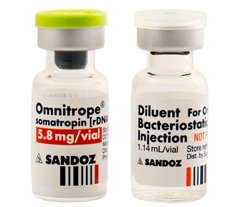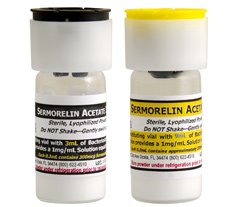Main differences between HGH and IGF-1 you should know about

Human growth hormone and insulin growth factor 1 are two very different, yet highly connected hormones. The endocrine system provides us with around 60 unique chemical messengers that control all the functions in the body.
Many of these hormones influence the secretion and functions of other hormones, stimulating or inhibiting their release, or mediating their effects. That is what we will explore by answering what is the difference between HGH and IGF-1? HGH and IGF-1 influence each other’s secretion, with IGF-1 mediating many of the effects of HGH.
The difference between growth hormone and IGF-1 begins with how these hormones enter the bloodstream. The pituitary gland is the primary manufacturer of HGH. There are cells called somatotrophs in the anterior region of the pituitary gland that have the sole purpose of producing and secreting somatotropin (growth hormone, GH) into the bloodstream.
These somatotrophs await a signal that comes from the hypothalamus by way of growth hormone-releasing hormone (GHRH), another crucial chemical messenger that stimulates the somatotrophs into action.
Instead of coming from an endocrine gland like many other hormones, IGF-1 comes from the liver. It is there, in that organ, that GH receptor cells receive input from growth hormone. That input stimulates the liver into producing insulin growth factor 1. IGF-1 is also produced by many different tissues in the body, although those effects are most often felt locally based on production.
HGH is a hormone secreted by the pituitary gland, IGF-1 production occurs primarily in an organ – the liver.
How Does HGH Influence IGF-1 Secretion?
The amount of growth hormone secreted by the pituitary gland has a direct impact on insulin growth factor 1 production. If the liver does not receive enough GH, as is the case when a person has a growth hormone deficiency, then the liver will produce less IGF-1.
As we examine the relationship between growth hormone and IGF-1, we also see that the amount of insulin growth factor 1 in the bloodstream can influence GH production. There are times when too much IGF-1 in the bloodstream can inhibit HGH secretion from the pituitary gland.
If the hypothalamus senses too much IGF-1 circulating in the bloodstream, it will reduce its release of GHRH to the pituitary gland. In turn, that will inhibit the action of the somatotrophs.
What is the difference between HGH and IGF-1 once they enter the bloodstream?
When the somatotrophs release a supply of human growth hormone, they do so in a pulsatile burst. These bursts occur on an average of once every three to five hours. Within a few minutes after entering the bloodstream, HGH binds with its receptors to deliver its signal and start its actions.
Once the binding of HGH to a receptor cell occurs, the HGH no longer exists in the bloodstream until the next pulse. When HGH binds to growth hormone receptors in the liver, the production of IGF-1 begins. Once secreted into the bloodstream, IGF-1 binds to one of 8 different binding proteins that carry it through the bloodstream.
Unlike HGH which leaves the bloodstream within minutes, IGF-1 remains present in the bloodstream. These proteins that bind with IGF-1 in the blood both extend the half-life of the hormone as well as modulating the interaction with IGF-1 receptors.
The secretory site of IGF-1 also determines its actions. When secreted by the liver, IGF-1 effects often mediate the functions of growth hormone. However, because IGF-1 production also takes place in other tissues, including cartilaginous cells, it acts locally where it was secreted as a paracrine hormone.
Aside from the stimulation of HGH to the liver’s growth hormone receptors, IGF-1 release responds to the following regulators:
- Age
- Protein intake
- Health
- Exercise
- Stress
- Insulin levels
- Sleep
- Nutritional intake
- Time of say
- Genetics
- Sex
HGH is the direct stimulator of IGF-1 production in the liver.
Functions and Benefits of HGH
As we look at the similarities and differences between HGH and IGF-1, we find these hormones interconnected in multiple ways. Aside from the influence on actual hormone production, IGF-1 mediates many of the functions of HGH.
What is HGH and why is it important?
Human growth hormone may well be the most vital of all chemical messengers in the body. HGH is a 191 amino acid polypeptide hormone that stimulates cellular growth, metabolism, brain functions, immunity, and more. The metabolic effects of growth hormone are well known and include:
- Carbohydrate metabolism – HGH helps keep blood glucose levels in a normal range through its anti-insulin activity. HGG suppresses insulin’s effects on peripheral tissue for the uptake of glucose.
- Fat metabolism – growth hormone stimulates the breakdown and oxidation of triglycerides in fat.
- Protein metabolism – HGH is a primary stimulator of protein anabolism in the body’s tissues. Also impacted by HGH are increased amino acid uptake, better protein synthesis, and reduced protein oxidation.
What is the difference between HGH and IGF-1 regarding the direct and indirect effects on the body?
Direct effects of HGH occur when growth hormone specifically binds to a receptor that brings about an action. An example of this is when HGH binds to a fat cell receptor to break down the triglycerides in the cells.
An indirect effect of HGH occurs when IGF-1 mediates the influence of growth hormone on a receptor cell, such as in muscle growth. Although growth hormone does stimulate cell regeneration, it does so with the aid of IGF-1 which supports protein synthesis in the muscle.
HGH has many functions in the body, exerting its influence in both direct and indirect ways via IGF-1 mediation.
Functions and Benefits of IGF-1
One difference between IGF-1 and HGH is how insulin growth factor 1 functions not only as an endocrine hormone but also as both a paracrine and autocrine hormone, depending on its release point. The many target tissues throughout the body that also produce IGF-1 dictate its function, as it acts locally in those areas rather than entering the bloodstream as it does when released by the liver.
What is IGF-1 and how does it influence the body?
Insulin growth factor 1 is a 70 chain amino acid. It has about 50 percent of the same structure as insulin. When IGF-1 production occurs in the liver, one of the primary functions is to mediate the effects of HGH throughout the body. It does so through cellular reproduction that helps support the bones, organs, muscles, skin, blood, cartilage, nerves, hair, eyes – essentially every cell in the body.
IGF-1 also modulates growth hormone effects on glucose metabolism and insulin action. Additional benefits of IGF-1 include decreasing inflammation, protecting the heart, and acting as a neurotrophic factor for cognitive health.
For additional information about the difference between HGH and IGF-1, please contact our hormone clinic. Consultations are confidential and provided at no charge.
Brian Leeber





















